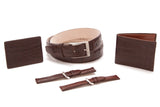Leather Types - Tips from the Experts June 30 2012


Jayme and Abram Mendal are brothers that founded the new American brand, Sterling Kane. They educated us on leather types and how to be a more sophisticated buyer of leather goods.
Tell us about Sterling Kane. We know you have a deep family history in this business.
We are third generation in a family of leather tanners. Our grandfather started work in the leather business in the 1950’s. He and his brother were running a 1,000+ person tanning, cutting and manufacturing operation in the US, Argentina and Colombia by the 1970’s. Having grown up learning from them, our father took over in the 1980’s and has been a leading supplier of exotic leathers to many of the world’s top luxury fashion houses. The third generation has now been active in the business for the past 15 years. We have grown the finished goods end of the business, having supplied bags, belts and small leather goods into fashion houses and retailers.
We hear a lot about different terms and types of leather. What are the primary differences between cowhide and calfskin and suede? What should our readers know about exotic skins?
Calfskin derives from a baby cow so the hide is smaller and the grain is tighter. This makes for a finer, more expensive product, typically used on belts, shoes and other luxury products. Whole cowhides run 22-50 square feet and are less expensive per square foot. Suede simply results from buffing the top grain of a cowhide.
The American alligator and saltwater crocodile from Southeast Asia are the kings of exotics. The skins of a few other crocodile species are traded, as well as many different types of snake skins, lizard skins, ostrich skins and a lot more. The sustainable trade of these products is regulated internationally by the Swiss-based CITES organization and nationally by the fish and wildlife departments of the approximately 180 CITES member nations.
Is there a difference between full-grain and top-grain leather? What about corrected grain and splits? How should this affect someone's purchase decision?
Full grain and top grain are the same thing. They represent using the top side of the hide without altering it, allowing it to maintain its natural characteristics. Corrected grain is when you sand off grain of lesser quality and apply prints, pigments or specialty finishes to cover up defects.
Cowhides are split to desired weights for different products. What results from the splitting is 1) the top grain (described above), and 2) the underside of that top grain also known as the split. The split is naturally sueded and can be used as sueded leather in fashion or for other products like rawhide dog bones and gelatin.
What exactly is involved in the leather tanning process? Why has there been a trend towards chrome and vegetable tanned leather?
Tanning is the process by which an organic material (animal skin) is transformed from organic to inorganic, meaning it is no longer susceptible to warm water or bacteria. Nowadays, most tanneries use chrome because it produces softer leather with the best physicals. Vegetable tanning used to be very popular. It is more environmentally friendly but the physicals aren’t as good. For example, the leather will change color quickly when exposed to sunlight. However, vegetable tanned leather does age and burnish well, so tanneries will often decide between chrome and vegetable tanning depending on the finish they intend to use. Lastly, wet white tanning involves using pure organic chemicals for environmental reasons.





